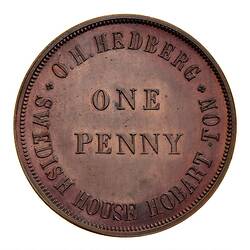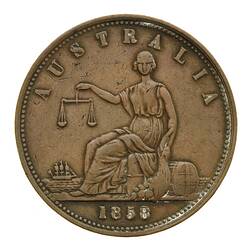Summary
This copper one Penny Pattern token was minted by W.J. Taylor of London, circa 1860. It was struck with the die combination Hedberg Reverse 2 and a Taylor Seated Australia form with waves accross the front of the land on which the figure sits. It is probably a pattern as the dies are in excellent condition. The British Museum received an example of this type in 1866.
Hedburg was originally from Sweden but settled in Hobart in 1844 and became involved in the whaling industry. After the decline of the whaling industry in the mid-1850s, he opened a business as a produce merchant and commission agent in Argyle Street, Hobart, it is from this business his tokens were issued.
Hedberg's main issue was quite standard, being a penny and a halfpenny. However it is confused by the existence of a large number of patterns, mules and late strikes. The regular series of issued tokens had no pictorial element. A second group of penny token patterns offered a variety of forms of the seated Australia while the third group, provide a variety of mules in both penny and halfpenny denominations and should be considered late strikes.
Physical Description
A round copper token (34 mm diameter) giving the name, address and business of : O.H. Hedberg, Swedish House, Hobart Ton (sic), together with the denomination. This was used as the reverse on Hedberg's standard issue. The reverse in this case is a figure of Australia seated on rock facing to left holding an olive branch extended in her right hand and resting a staff on her left forearm; above, AUSTRALIA. A pattern of waves extends across the front of the land on which she sits and forms the exergue line and the mint name, W.J. TAYLOR LONDON extends along the beaded border to right and left.
Obverse Description
Across centre in two lines, ONE / PENNY around above, * O.H. HEDBERG * around below, SWEDISH HOUSE HOBART TON
Reverse Description
Australia seated on rock facing to left holding an olive branch extended in her right hand and resting a staff on her left forearm; above, AUSTRALIA. A pattern of waves extends across the front of the land on which she sits and forms the exergue line and the mint name, W.J. TAYLOR LONDON extends along the beaded border to right and left.
Edge Description
Plain
More Information
-
Collecting Areas
-
Acquisition Information
Purchase from Spink (Australia), Jul 1983
-
Date Issued
circa 1860 AD
-
Issued By
O H Hedberg, Hobart, Greater Hobart, Tasmania, Australia, 1855-1866
-
Mint
W.J.Taylor, Mint, London, England, Great Britain, 1855-1866
The British Museum received an example of this pattern in 1866. -
Inscriptions
Obverse: O.H. HEDBERG SWEDISH HOUSE HOBART TON ONE PENNY Reverse: AUSTRALIA W.J. TAYLOR LONDON
-
Denomination
-
Series
-
Material
Copper
-
Axis
12
-
Classification
-
Category
-
Discipline
-
Type of item
-
Dimensions
34 mm (Outside Diameter), 18.18 g (Weight)
-
Shape
Round
-
References
This pattern was struck with the die Reverse 2 as its obverse and a seated Australia die as reverse. It is one of a series of trials with different forms of Australia. Hedberg's main issue was quite standard, being a penny and a halfpenny . However it is confused by the existence of a large number of patterns, mules and late strikes. The regular series of issued tokens had no pictorial element. A second group of penny token patterns offered a variety of forms of the seated Australia while the third group, including this token, provide a variety of mules in both penny and halfpenny denominations and should be considered late strikes. Die identification for the regular series penny Obverse top bar O.H. HEDBERG & C A relationship to H Border beads A 6.0 mm 10.0 mm 21.2 mm 1.0 mm points to top 167 B 6.0 mm 11.0 mm 20.0 mm 1.2 mm points above top 162 C 5.0 mm 10.5 mm 20.4 mm 2.2 mm points to top 167 Reverse PENNY G to * Border Beads 1 14.9 mm 0.5 mm 165 2 16.3 mm 1.2 mm 165
[Book] Andrews, Arthur. 1921. Australasian Tokens and Coins., No. 200
[Book] Heyde, Gilbert C. & Skinner, Dion H. 1967. Unofficial Coins of Colonial Australia and New Zealand., Related to No. 33/1
-
Keywords



